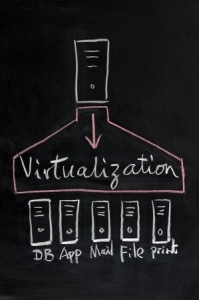In part one of a two part series, Alex Watson-Jackson looks at virtualisation – where it started, what it is now and where it is going, to offer six very good reasons to virtualise.
What gave virtualisation its current buzzword status was the ability to apply it in the Wintel environment, via tools such as VMware. Suddenly, it was possible to consolidate the Wintel world and, as a result, there was practically no element of the technology environment that could not be reconfigured in a more efficient and effective form – including servers, storage, desktop and networks.
And make no mistake, that consolidation capacity can enable huge benefits. I can name two very good examples off the top of my head:
- An organisation that started with 750 servers, but no capacity, and ended up consolidating its server estate by a factor of 26:1. The storage crisis was solved and, as an added benefit, data centre energy costs fell by 94%
- Another consolidated 94 servers down to just four – an effective reduction, when you factor in power, floor space and cabling, of 96%.
However, these days virtualisation is about so much more than consolidation, which is why I refer to it as a journey in the title of this blog.
Today, virtualisation opens the door to a host of immediate benefits, but also sets organisations on the road to a whole new technology infrastructure model – one that transforms the role of the CIO and indeed that of the IT department itself.
In this brave new world, which I will explore in part 2 of this series, the IT department is transformed from a support role to an active and crucial participant in the development of a winning business strategy.
For now, though, here are six very good reasons to virtualise:
- Virtualisation offers dramatic savings from server and storage consolidation; it’s a compelling technology that allows technology pros to do the same things better, faster and cheaper, resulting in improvements in performance and management as well as savings in money and energy.
- Virtualisation makes it possible to reduce the number of physical servers needed by an average of 15-to-1 and ensures that all servers are running at appropriate load levels.
- Systems that would have taken months to deploy in the physical world can be deployed in weeks in a virtualised environment.
- The relative ease and affordability virtualisation offers when implementing improved disaster recovery (DR) strategies with better recovery times is of particular appeal to IT directors who have been leaving the office every day for years with their fingers crossed, worrying about how long their companies would be down in the event of an emergency.
- When the hardware layer is separated and abstracted with virtualisation, IT won’t need to deal with all of the details of specific device drivers for one machine or another, or patching from one vendor to another. The hardware layer becomes much further removed and a less significant part of the overall management strategy.
- Physical servers, by virtue of becoming virtual servers, inherit the high availability with failover redundancy that the virtualisation layer provides in a virtualized environment.
Ignore them at your peril – you’ll be overlooking a whole host of cost and time efficiencies – but worse, you’ll risk leaving your own role (and your IT department) in the dark ages by failing to realise the transformative effect that virtualisation can have on systems design and management.
As I’ll explore in part 2 of this series, this transformative effect is underpinned by the sheer level of centralised control that virtualisation makes possible – provided it is coupled with proper and far-sighted planning.
Right now, this heady mix is enabling IT pros to implement dynamic data centre environments consisting of pools of high-performing computing resources that can be centrally managed, readily automated and efficiently maintained - and with an upgrade path that is evolutionary instead of disruptive.
But more on that next time…

